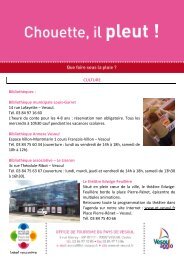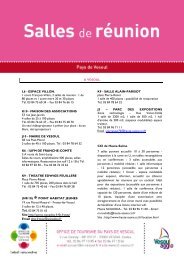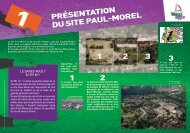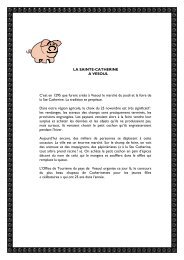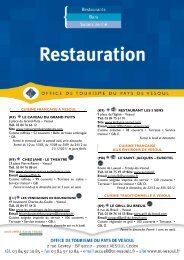VVesoul - GB - Office de Tourisme du pays de Vesoul
VVesoul - GB - Office de Tourisme du pays de Vesoul
VVesoul - GB - Office de Tourisme du pays de Vesoul
You also want an ePaper? Increase the reach of your titles
YUMPU automatically turns print PDFs into web optimized ePapers that Google loves.
<strong>GB</strong><br />
We invite you to visit the old town...<br />
<strong>Vesoul</strong>, is first and foremost “la Motte”, the instantly recognisable mount overlooking the Durgeon valley. This<br />
hill was in the past an area very swampy that generations of “Vésuliens” have tried to drain off until the creation<br />
of an artificial lake in 1978.<br />
By the end of the 10 th century, a castle was built on the narrow platform of “La Motte” (378 meters) in whose<br />
shadow a little town surroun<strong>de</strong>d by walls grew up in the 13 th century.<br />
Situated as it was on a Roman road, the town <strong>de</strong>veloped a thriving tra<strong>de</strong> in agricultural pro<strong>du</strong>cts, leather and wine<br />
from “La Motte”. As a result of this activity, salesmen settled in <strong>Vesoul</strong>, among them a powerful Jewish<br />
community having its own school and synagogue. However, <strong>Vesoul</strong> really <strong>de</strong>veloped in 1333 when it became the<br />
capital of the “Baillage d’Amont”, and thus inherited an administrative vocation that has been kept until now.<br />
In the 14 th century, the region was <strong>de</strong>vastated several times by outbreaks of plague and the wars between the<br />
King of France and the mighty Duke of Burgundy (ruler of Franche-Comté at that time). The troops of Louis XI<br />
attacked the castle on no less than eight occasions, leaving the town in a lamentable state in 1479. Franche-Comté<br />
then passed into the hand of the Spaniards and a period of relative peace ensued for a hundred years.<br />
In the 16th century, tra<strong>de</strong>smen, lawyers and civil servants from the “Baillage” ma<strong>de</strong> a lot of money and thus were<br />
able to repair the town. However, in 1595, strife broke out once more: the walls were shattered, the<br />
townspeople massacred and the castle razed to the ground. In the early years of the 17th century, a wave of<br />
religious fervour swept over the country and led to the founding of convents. Four of them were built within ten<br />
years, such as the Jesuit convent, which taught law and rhetoric, while the Ursulines convent exclusively <strong>de</strong>voted<br />
itself to young women’s e<strong>du</strong>cation.<br />
In the middle of the 17th century, the kings of France resumed their attempt to annex Franche-Comté. In the<br />
ensuing struggle <strong>Vesoul</strong> lost half its population and fields, and crops were <strong>de</strong>stroyed. In 1678, the Franche-Comté<br />
became a French province. With the return of peace, tra<strong>de</strong> <strong>de</strong>veloped and the town prospered and expan<strong>de</strong>d.<br />
Beautiful resi<strong>de</strong>nces both sober and austere were built, and some gar<strong>de</strong>ns were created. The church and the law<br />
courts were reconstructed. Barracks were built on recently rehabilitated ground in the lower part of the town to<br />
accommodate a cavalry regiment, and the hospital built in 1619 was enlarged.<br />
High up on the hill of the Motte, there is now a chapel that was constructed in 1854 and partially rebuilt in 1966<br />
after it caught fire. The chapel reminds that the town escaped the terrible cholera epi<strong>de</strong>mic in 1854.
Rue Roger-Salengro<br />
Rue d’Alsace-Lorraine<br />
1. At the bottom of the street,<br />
you will find the “Porte Basse”<br />
with a drawbridge. The river<br />
“Périlleuse” (or the “Pouilleuse”)<br />
bathes the ramparts. Walking<br />
back up the street, you can see :<br />
2. N°22 : a beautiful house from<br />
the 18 th century.<br />
3. N°10 : in a <strong>de</strong>ad end, an old<br />
Jewish quarter.<br />
4. N°9 : the house where the<br />
well-known French painter Jean-<br />
Léon Gérôme was born.<br />
5. N°3-5 : a house from the end<br />
of the 16 th century.<br />
6. N°4-2 : a huge house from<br />
the end of the 16 th century with<br />
three floors of paired windows<br />
and arches for the ancient stalls.<br />
7. N°9 : the hotel Burtel from the 15 th century whose courtyard has astonishing columns and gives<br />
access to the old wine cellars with intersecting ribs. At the end of the street, there was in the past a<br />
<strong>de</strong>fence tower surroun<strong>de</strong>d by ramparts (inscribed “Impasse <strong>de</strong> la Défense”).<br />
8. N°11 : the hotel Thomassin, from 1480-1483, one of the most elegant houses in the town, with its<br />
twisted doorframes and windows, and the chamfer guttering in a typically “comtois” style. A few steps<br />
away, turn right : you are in the gar<strong>de</strong>n. Here stands a tower and outbuildings from the 15 th century<br />
roofed with beautiful glazed tiles in a very “Bourguignon” style. The wing and the semicircle gate date<br />
back to the 17 th century.<br />
Rue Beauchamp<br />
9. You walk along one of the faca<strong>de</strong>s of the ancient Jesuit convent. Further along, in a park, you will find<br />
the former teacher training college (from the beginning of the 10 th century).<br />
11. You cross a small gar<strong>de</strong>n surroun<strong>de</strong>d with bor<strong>de</strong>rs at the rear of the Ursulines convent. The round<br />
tower belonging to a house from the 16 th century stands not too far from it. In the porch, open the<br />
door and see the old spiral staircase.<br />
You arrive at the “Place <strong>du</strong> Trau” where you will find an enormous wine vat in which winegrowers<br />
would have put their grape-harvest.<br />
12. Going downstairs, you are now in front of the gate (Renaissance style - 1716) of the Ursulines<br />
convent from 1680. Insi<strong>de</strong> is a beautiful courtyard, now the museum.
Rue <strong>de</strong>s Annoncia<strong>de</strong>s<br />
13. N°6 : a courtyard from the 17 th century.<br />
14. The high building lining the street is the old Annoncia<strong>de</strong>s convent (1613). Take the Annoncia<strong>de</strong>s<br />
passage (“traige”) where stairs and passageways follow each other between houses from the 16 th and<br />
17 th centuries.<br />
15. You then arrive in the rue Petitclerc by the courtyard of a 17 th century house (interesting oak door<br />
and railing balcony).<br />
Rue <strong>de</strong> Mailly<br />
16. The street is lined with hotels :<br />
At number 1, you will find the hotel <strong>de</strong> Magnoncourt (1510) : its tower with Thomassin’s coat of arms,<br />
its staircase with huge pillars and its wing which was entirely rebuilt in the 18 th century. Two other<br />
hotels were built in the same century.<br />
Notice on your right a door that stands at one meter of the ground: this allowed the easy loading and<br />
unloading of carts.<br />
17. Before you take the rue <strong>du</strong> Châtelet, go in and have a look at the woo<strong>de</strong>n staircase in the<br />
courtyard.<br />
Rue <strong>du</strong> Châtelet<br />
18. At number 5, if you pay attention you will be able to see a house from the 16 th century (one of the<br />
most prestigious of the town before the fire in 1895) as well as its tower. The street has kept the same<br />
appearance since the 16 th century.<br />
N°17 : a gothic door is concealed at the far end of the courtyard. At the end of the <strong>de</strong>ad end, go down<br />
the stairs: you are on the site of the ancient “Porte Haute”.<br />
Rue Baron-Bouvier<br />
This wi<strong>de</strong> road lined with beautiful houses is very characteristic of the 18 th century.<br />
At number 14, you will find several old workshops. At the top of the street stands the old Capucin<br />
convent (now the hospital).<br />
As you head towards the place <strong>du</strong> Grand-Puits, you can see some interesting houses :<br />
19. For instance, at number 2, the elegant and refined hotel <strong>de</strong> Mongenet (1549) with its wi<strong>de</strong> accola<strong>de</strong><br />
gate <strong>de</strong>corated with cable mouldings.<br />
20. At number 1, the maison Carriage (15 th C) is a roughcast half-timbered house.<br />
Place <strong>du</strong> Grand-Puits<br />
21. At number 3, opposite to you, there is the hotel Raillard <strong>de</strong> Granvelle (18 th C) with a beautiful<br />
wrought iron balcony.<br />
22. Near the “Puits”, you can see the sumptuous hotel Lyautey <strong>de</strong> Colombe (1712) : a simple and<br />
harmonious building.<br />
At number 2, notice the row of iron railings (called “rejeas”). At number 20, un<strong>de</strong>r the porch, you will<br />
find the hotel Fyard <strong>de</strong> Mercey from the end of the 15 th century.<br />
Place <strong>du</strong> Palais<br />
Around this square, you can see successively :<br />
the law courts (the old presi<strong>de</strong>ntial palace from 1771).<br />
23. Facing the law courts, at number 3, the maison Barberousse (15 th C). Notice the steep roof, the<br />
stone crossed windows, the beautiful basket-handle arch surmounted by a cartouche and the surprising<br />
sundial. “A Dieu seul la gloire” (“Glory to God”) is the motto inscribed above the door of the<br />
neighbouring house from the 17 th century.
24. The maison Petremant is a beautiful building from the 18 th century. The buil<strong>de</strong>r’s initials are written<br />
down on its balcony railings (situated above the café).<br />
25. Before taking the rue <strong>de</strong>s Boucheries, turn into the small rue <strong>du</strong> Palais where you will see a tower<br />
from the 15 th century and the door of the hotel d’Hortelans in the rue Leblond in front of you.<br />
Rue <strong>de</strong>s Boucheries<br />
26. The hotel Beauséjour from the 16 th century : its gate with a niche gives access to the hotel<br />
courtyard.<br />
27. At number 14, you will find the hotel Simon Renard. Its faça<strong>de</strong> and its gate were renovated in the<br />
18 th century. Come on in. Simon Renard, the ambassador of Charles the Fifth of Spain, built this hotel in<br />
1525. Notice the ceiling in the porch, the hexagonal tower, the gargoyles and the gothic door. The<br />
traces of the 18 th century are particularly visible from the right-hand wing.<br />
Now, wend your way towards the rue <strong>du</strong> Fort. This street will take you to the rue Georges Genoux<br />
which approximately follows the old ramparts.<br />
Square Flavigny<br />
To your left are the new houses of <strong>Vesoul</strong> that replace the old living quarters of the town. To your<br />
right, you can see remaining buildings from the 15 th and 17 th centuries.<br />
Place <strong>de</strong> l’Eglise<br />
28. The church was originally rebuilt in 1745.<br />
Insi<strong>de</strong>, you will find interesting furniture, for<br />
instance a “Pieta” and a “Mise au tombeau” from<br />
the 16 th century ma<strong>de</strong> with polychrome stones (on<br />
your right as you go in). To your left, before the<br />
pulpit, you will see a marble statue with misty eyes<br />
representing the faith of Canova (18 th C). Notice<br />
also Rabini’s beautiful organ from 1776.<br />
At the corner of the street, to your left, look at<br />
the faça<strong>de</strong> of the hotel d’Aigreveaux. Facing the<br />
church, at number 18, the maison Parat : a really<br />
harmonious building from the 15 th century. Notice<br />
the wine cellar entrance with triple arches. The square is lined on the right with houses from the 16 th<br />
and 17 th centuries.<br />
29. N°2 is the maison Baressol (15 th C), one of the most curious in <strong>Vesoul</strong> with its gables and its high<br />
lancet window.<br />
From the wrought iron gate situated un<strong>de</strong>r the porch one could have seen who was entering the<br />
Annoncia<strong>de</strong>s passage.<br />
30. Meeting place<br />
Gui<strong>de</strong>d tours are organized every Tuesday and Thursday at 4 pm from June 15 th to September 15 th .<br />
For group visits, please phone the Tourist <strong>Office</strong>, 2 rue Gevrey, number : (+33) (0)3 84 97 10 85.<br />
Ma<strong>de</strong> by ourselves.<br />
Don’t throw anything on public way, please use the <strong>du</strong>stbin.<br />
Modifications on 06.11.2008



